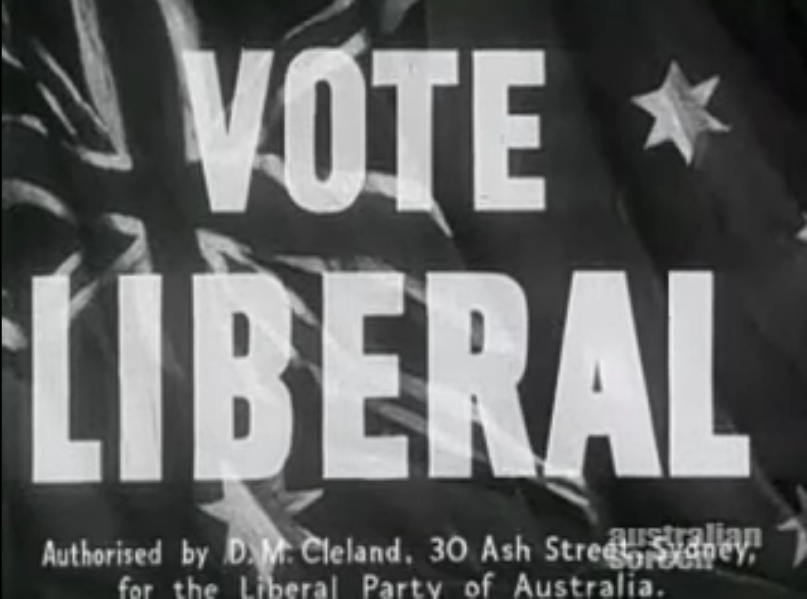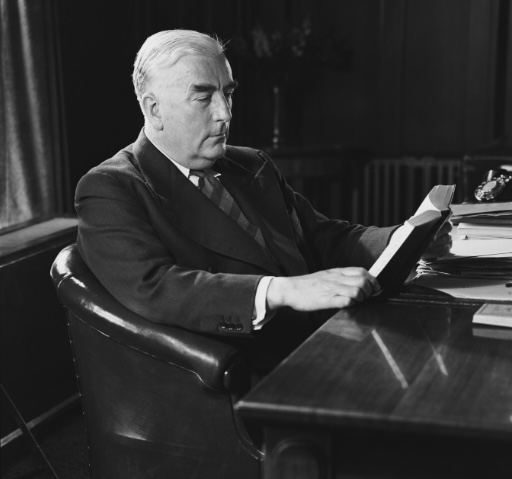On this day, 16 October 1944, the Non-Labor Unity Conference meeting in Canberra adopts the name the ‘Liberal Party of Australia’ for the new political formation of the Australian centre-right. The Liberal Party would replace the defunct United Australia Party and bring together splinter parties which had broken off from the UAP. The date is often recorded as the foundation date of the Liberal Party, though this is open to debate, as its constitution and organisational structure would not be formed until a later meeting at Albury in December.
In his memoir Afternoon Light Robert Menzies wrote that ‘we took the name “Liberal” because we were determined to be a progressive party, willing to make experiments, in no sense reactionary but believing in the individual, his rights, and his enterprise, and rejecting the Socialist panacea’. However, the choice was not as straight forward as this makes out.
The name ‘Liberal’ was one of several options considered by the Conference, the others being ‘Conservative’, ‘Democratic’, ‘Nationalist’, ‘Constitutionalist’ and ‘Commonwealth’. Indeed, for a while the name ‘Liberal’ was considered unsuitable because ‘the great Liberal Party of Britain has outlived its usefulness and the use of the name in Australia savours of looking backward instead of forward’. There had already been a ‘Liberal Party’ at the Commonwealth level, formed out of the fusion of the Free Traders and Protectionists, and it had only ever won one election under Joseph Cook before being absorbed into the Nationalists amidst the turmoil of the First World War.
On the other hand, the label ‘Conservative’ had long been an anathema in Australian politics and therefore offered a poor alternative. True Tory-style British conservatism was based on the twin pillars of a landed aristocracy and a government-backed Church of England, but attempts to transport these relics to Australia had ultimately failed, leading to a liberal ascendency.
In the various nineteenth century colonial parliaments practically every politician described themselves as ‘liberal’, even when they were avid followers of the principles of Edmund Burke (who himself had been a Whig rather than a Tory). This liberal-ascendency helps to explain how liberalism came to be associated with the centre-right in Australia, in a manner which is not the case elsewhere. Though there were certainly areas in which they sought further progress, on the whole liberals became defenders of the status-quo because it was a liberal status-quo.
This centre-right liberalism was pioneered by Joseph Carruthers, arguably the first politician to see that a Labor vs Liberal divide would form the basis of Australian politics. In 1902 he founded a ‘Liberal Party’ in New South Wales which sought broad ideological support, rejected the role of sectional interests in politics, and determined to project a positive rather than reactionary alternative to socialism. This model had been carried over into federal politics and enjoyed brief success under Cook, whose government received the backing of Federal MP and Menzies’s uncle Sydney Sampson. All of this would be echoed by Menzies, who reflected what were by then long-established values of non-Labor Australian politics, albeit ones that had been somewhat obscured by two successive mergers with Labor defectors (Billy Hughes and Joseph Lyons).
In these circumstances, Menzies’s adoption of the term ‘Liberal’ represented a return to tradition, and one which could comfortably accommodate what has since been dubbed the ‘broad-church’ of liberal and Burkean thought. The other names considered were all largely hollow ideologically, reflecting little more than non-Labor’s claim to govern for the whole community in self-styled contrast to Labor’s sectional union basis.
Notably both Menzies and Carruthers were keen admirers of the British Liberal giant William Gladstone, and it was his approach they wanted to evoke when styling their parties ‘Liberal’. Gladstonian liberalism valued individual freedom, human progress as something that was fuelled by the exercise of that freedom, restraint in government expenditure, and democratic reform, all within a framework that cherished existing institutions as entities that had evolved over time to become the best means through which to carry forward progress and consolidate new and existing freedoms.
Menzies was also evoking the memory of Alfred Deakin, who was still greatly admired in his home State of Victoria, even though he led the fusion Liberal Party to electoral disaster, and he had never won a majority in his own right. Deakin’s ‘new liberal’ ideology envisaged a far greater role for the state than the classical liberalism of Gladstone, and he was less comfortable with a centre-right liberal orientation than Carruthers’s good friend George Reid. Menzies arguably pursued a middle approach which accepted the Deakinite legacy of the ‘Australian Settlement’ and the levers of Keynesian economic management, but which maintained an emphasis on anti-socialism, a degree of Burkean conservatism, and the importance of the individual in driving further progress.
Further Reading:
David Furse-Roberts, ‘How the Liberal Party got its Name’, Quadrant, December 2019.
Graeme Starr, The Liberal Party of Australia: A Documentary History (Drummond/Heinemann, 1980).
Zachary Gorman, Sir Joseph Carruthers: Founder of the New South Wales Liberal Party (Connor Court, 2018).
Sign up to our newsletter
Sign up for our monthly newsletter to hear the latest news and receive information about upcoming events.


